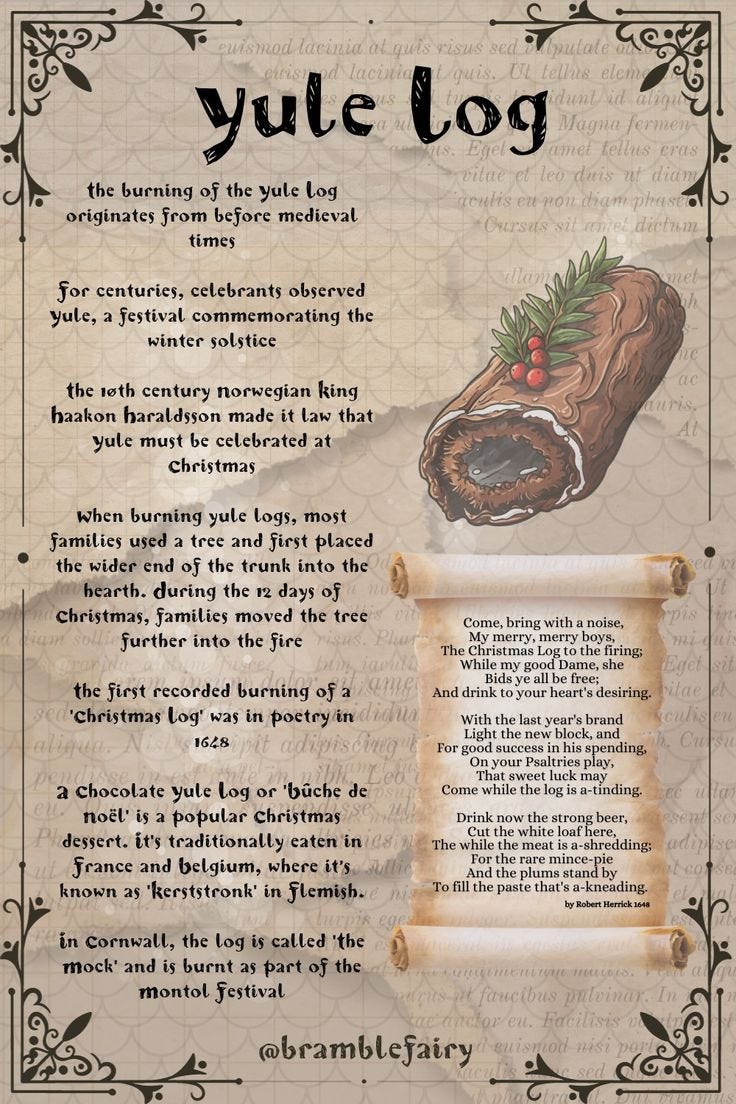The Yule log is a cherished winter holiday custom that has warmed homes and hearts for centuries. With roots stretching back to ancient times, this tradition has evolved to remain a festive staple in many cultures around the world.
Origins
The idea of the Yule log dates back to the Proto-Indo-European era and is reflected in various traditions across Albanian, Celtic, Germanic, Baltic, and Slavic paganism. However, it is most closely associated with the Nordic tradition. The term "Yule" itself comes from the old Winter Solstice festivals in Scandinavia and northern Europe.
the first recorded burning of a 'Christmas Log' was in poetry in 1648. The term 'Yule Log' is first documented in 1686.
Medieval Practices
During medieval times, the Yule log was often an entire tree or a very large log, ceremonially brought into the house to celebrate the Yule festival. The largest end of the log was placed in the hearth and lit, while the rest of the tree extended into the room. Over the Twelve Days of Christmas, the log was slowly fed into the fire. This ritual symbolized the return of the sun and the lengthening of days, imbuing the dark winter nights with light and warmth.
Adoption into Christianity
As Christianity spread through Europe, many pagan practices, holidays, and traditions were absorbed and given new meaning. The Yule log continued as a symbol of a coming light that would bring peace and joy
Modern Traditions
As heating methods modernized, the practice of burning an entire tree became less practical. However, the essence of the tradition has endured. In Provence, France, families still partake in cutting a log together, burning a bit each night, while some in the Netherlands store the log under a bed for protection. Even in modern homes, smaller logs are used, maintaining the spirit of the ancient custom.
Cultural Variations
Different regions have their unique takes on the Yule log tradition. For instance:
In England, oak is the wood of choice.
In Scotland, birch is commonly used.
In France, cherry wood is favored, and the log is often sprinkled with wine before burning to release a pleasant aroma. (Bûche de noël)
Yule Clog: A common term in north-east England
Yule Block: A common term in the Midlands and West Country
Gule Block: A common term in Lincolnshire
Stock of the Mock: A common term in Cornwall
Boncyff Nadolig or Blocyn y Gwyliau: A common term in Wales
Christklotz, Christbrand, Christblock, Julklotz, or Julblock: A common term in Germany
The Yule log has also inspired culinary traditions, such as the popular Yule log cake (Bûche de Noël), a delicious and festive treat during the holiday season.
Adding Color to Yule Logs
Different chemicals can be sprinkled on the log like wine to make the log burn with different colored flames!
Potassium Nitrate = Violet
Barium Nitrate = Apple Green
Borax = Vivid Green
Copper Sulphate = Blue
Table Salt = Bright Yellow
Edible Yule Logs
A Chocolate Yule Log or 'Bûche de Noël' is now a popular Christmas dessert or pudding. It's traditionally eaten in France and Belgium, where they are known as 'Kerststronk' in Flemish.
They are made of a chocolate sponge roll layered with cream. The outside is covered with chocolate or chocolate icing and decorated to look like a bark-covered log. Some people like to add extra decorations such as marzipan mushrooms.
Conclusion
The Yule log is a timeless tradition that has adapted to changing times while retaining its symbolic significance. It continues to bring warmth, light, and a sense of continuity to winter celebrations across different cultures, serving as a reminder of our shared heritage and the enduring power of holiday rituals.






Thank you, I never knew where it started or why.